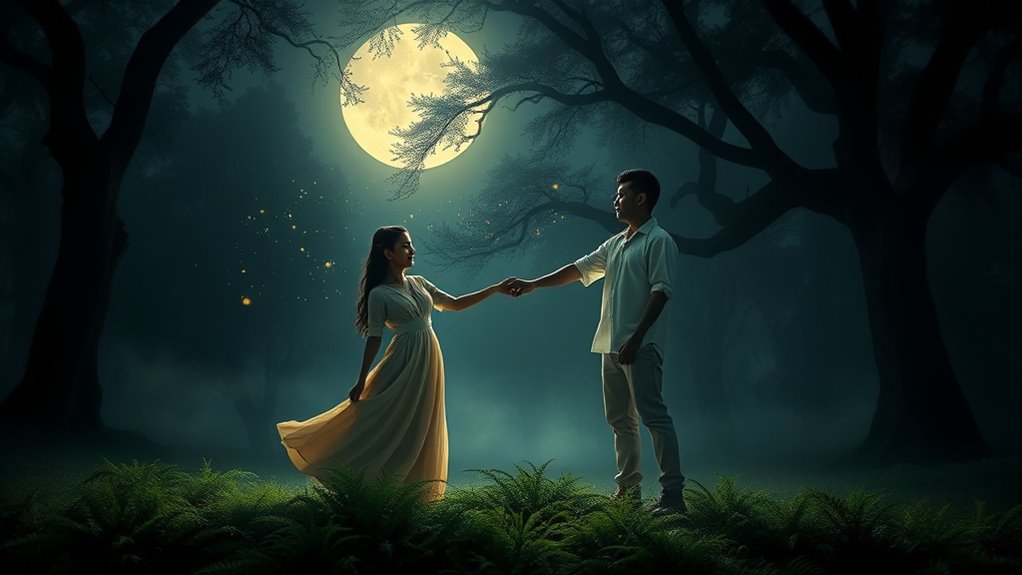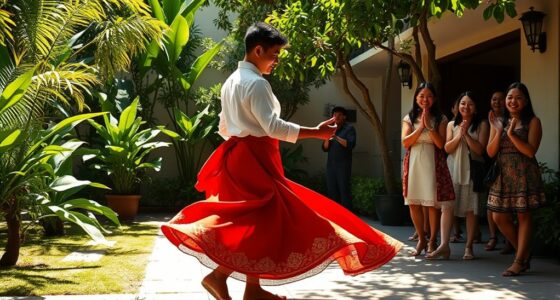Filipino folklore inspires love stories through themes of transformation, magic, and nature. You’ll find characters like aswang and diwatas intertwining romance with supernatural elements. Mythological couples often challenge social norms, while enthralling landscapes enhance emotional connections and set the stage for enchanting encounters. Tragic outcomes reveal love’s complexities, and stories reflect cultural values and community bonds. Explore how these elements create powerful narratives that resonate today, and uncover even more fascinating layers of this rich tradition.
Key Takeaways
- Filipino folklore weaves themes of transformation and magic into love stories, emphasizing the fluid nature of identity in romantic relationships.
- Mythological couples challenge societal norms, promoting acceptance of diverse love, particularly resonating with LGBT communities in contemporary narratives.
- Emotional depth and tragic outcomes in folklore highlight love’s complexities, illustrating the sacrifices and loyalty required within societal constraints.
- Cultural significance in folklore fosters community bonds, with shared stories reinforcing values of unity, sacrifice, and the importance of family in relationships.
- Modern adaptations of folklore keep stories relevant, blending traditional elements with contemporary themes to resonate with new generations and evolving societal values.
Transformation and Magic in Romantic Narratives

When you explore Filipino folklore, you’ll discover that transformation and magic play pivotal roles in shaping romantic narratives. Characters like the aswang and manananggal showcase fluidity in identity, turning the ordinary into the extraordinary. These creatures symbolize the complexities of love, where relationships can morph through trials, just like a tikbalang’s blend of human and animal traits. The kapre, a giant guardian, reminds you that transformation can also embody protection in love.
With enchanting tales like Bakunawa, who evolves from a sea nymph to a celestial pursuer, magic becomes a metaphor for personal growth. Through these narratives, you see the power of change, urging you to embrace the unknown and adapt in your own romantic journey. Additionally, much like AI-driven personalization in e-learning, these stories emphasize the importance of understanding individual experiences and adapting to them for deeper connections. Just as chia seeds can enhance weight loss by promoting satiety, these tales encourage you to find fulfillment in the journey of love.
The Influence of Mythological Couples

Mythological couples in Filipino folklore, such as Libulan and Sidapa, serve as powerful symbols of love that transcends societal boundaries. Their story, which highlights an unconventional union between gods from different domains, resonates with many, especially among LGBT Filipinos who see Libulan as a patron of diverse love. This tale promotes acceptance and celebrates differences, inspiring countless stories of unlikely pairings overcoming challenges, much like how essential oils can enhance emotional well-being in various settings. Artists often depict their love in various forms, emphasizing unity and harmony. Additionally, the significance of soulmate angel numbers can be seen as a reflection of the deep connections celebrated in these mythological narratives.
Nature and Spirits as Romantic Backdrops

Amidst the enchanting landscapes of the Philippines, love stories often unfold under the watchful eyes of nature and spirits, creating a magical backdrop that elevates their narratives.
Majestic mountains like Mount Madjaas serve as the home of powerful deities, while the beauty of flowers and plants in tales like Sidapa’s highlights the connection between love and nature.
Mount Madjaas stands as a sacred abode for deities, intertwining love’s essence with the beauty of nature’s blooms.
Diwatas, or nature spirits, nurture environments where romance can flourish, ensuring love thrives under their protection.
Rivers, as seen in the legend of Maria Cacao, play essential roles, transforming ordinary moments into magical encounters.
These ethereal settings weave mysticism into love stories, representing growth, transformation, and the deep emotional ties between lovers and their natural surroundings. Additionally, the influence of local history often enriches these narratives, reflecting cultural beliefs and traditions that shape the characters’ journeys.
Social Hierarchies and Love Stories

The enchanting settings of Filipino folklore often contrast with the rigid social hierarchies that shape love stories. In tales like “Aponibolinayen,” gaining family approval is essential for marriage, highlighting how familial influence dictates romantic choices.
Your social status can determine your suitability as a partner, as wealth and lineage often take precedence. Cultural traditions, such as presenting gifts and respecting elders, are vital for securing love, emphasizing the importance of hierarchy.
These narratives reflect traditional gender roles and community involvement, showcasing how societal expectations mold relationships. Ultimately, the pursuit of love in these stories navigates the complexities of power dynamics, as characters often seek approval from family and society while grappling with the constraints imposed by their statuses. Additionally, the emotional well-being of individuals involved is crucial, as open communication about feelings can significantly affect relationship dynamics.
Tragic Outcomes in Filipino Romance

While love often inspires passion and joy, tragic outcomes frequently loom large in Filipino romance, reminding us of the harsh realities that can accompany deep affection.
Tales like that of Daragang Magayon and Panganoron illustrate how love can lead to devastating endings, with jealousy and external conflicts often tearing lovers apart.
Nature serves as a powerful backdrop, symbolizing the turmoil and heartbreak characters endure. The legends emphasize themes of sacrifice and loyalty, showcasing how love can demand everything, even life itself.
You’ll find that these narratives reflect cultural values, offering cautionary lessons about the fickleness of fate and the consequences of unchecked emotions.
Ultimately, they remind us that love, while beautiful, can also bring profound sorrow.
Historical Context of Love in Folklore

Exploring the historical context of love in Filipino folklore reveals a rich tapestry of beliefs and values that shaped relationships long before colonial influences took hold.
In pre-colonial societies, love was celebrated with an emphasis on equality and acceptance across genders. Women enjoyed equal rights, and stories featured intersex and genderfluid deities like Lakapati, showcasing fluid identities. This absence of strict gender roles allowed for inclusive depictions of love relationships.
Mythological narratives often centered on mutual respect and companionship, as seen in the tale of Libulan and Sidapa. Indigenous practices further honored diverse love through rituals celebrating fertility and community, reinforcing the notion that love transcends traditional norms, enriching Filipino folklore’s legacy of diverse and complex relationships.
Symbolism of Nature and Magical Beings

Nature and magical beings in Filipino folklore serve as powerful symbols that deepen our understanding of love and relationships. Natural elements like the sea, sky, and land reflect the intimate connection between love and the environment.
For instance, Libulan, the moon god, symbolizes desire, while creation stories like Si Malakas at Si Maganda illustrate love’s roots in nature. Magical beings, such as the androgynous Lakapati, embody balance and acceptance in love.
The divine romances of deities, like the union of Maguayan’s daughter and Captan’s son, symbolize harmony between natural forces. These myths reveal how nature mirrors human emotions, showcasing the intricate relationship between love and the world around us, ultimately enriching our understanding of romance and connection.
The Theme of Forbidden Love

Filipino folklore often intertwines with themes that reflect the complexities of human emotions, and forbidden love emerges as a poignant narrative thread.
You’ll find stories where characters from different social classes or spiritual domains face societal taboos. Relationships like that of Piriang and a demon showcase the pressures that lead to tragic ends.
Mythological creatures like Diwatas symbolize love’s uncontrollable nature, while divine intervention often complicates these affairs.
Tales like Guanchiango’s caution against forbidden alliances, illustrating the risks involved.
Through oral storytelling and modern adaptations, these narratives reveal the emotional depth of love constrained by societal norms, offering moral lessons about loyalty and duty that resonate even today.
Cultural Significance of Folklore in Love Stories

While many cultures celebrate love through stories, the rich tapestry of Filipino folklore reveals how deeply intertwined these narratives are with cultural identity.
The diverse sources of inspiration, from mythical creatures to legendary heroes, create vibrant love stories that resonate emotionally. Characters like Diyan Masalanta symbolize love’s depth, while tales connected to landmarks like Mayon Volcano provide unique settings for romance.
These stories promote values such as unity, sacrifice, and transformation, guiding personal relationships. Shared through oral traditions and festivals, folklore fosters community bonds and preserves cultural heritage.
In this way, Filipino love stories not only entertain but also educate, offering moral lessons that enrich the understanding of love and its significance in everyday life.
Adaptation and Evolution of Folklore Tales

As cultural landscapes shift and evolve, folklore tales adapt to resonate with new generations. You’ll notice characters like Maria Makiling and Daragang Magayon getting modern twists while still embodying their traditional roles.
These stories often incorporate international influences, blending European fairytales with local narratives. By updating settings to contemporary environments, they retain their relevance.
Themes of love and sacrifice evolve, reflecting today’s societal values. Multimedia adaptations, from films to digital content, help broaden their reach.
Oral traditions continue to play an essential role, allowing dynamic retellings and preserving regional variations. Community engagement in storytelling fosters adaptation, while technology and social media enable innovative interpretations, ensuring these tales remain alive and impactful in modern culture.
Frequently Asked Questions
How Do Modern Filipino Love Stories Differ From Traditional Folklore?
Think of modern Filipino love stories as a vibrant tapestry woven with threads of independence, while traditional folklore is more like a warm, familiar quilt.
You’ll notice that modern tales often showcase career-driven characters and urban settings, unlike the pastoral charm of folklore.
Today’s narratives spotlight strong, empowered individuals, breaking free from societal norms, while traditional stories emphasize community ties and customs, revealing a fascinating evolution in themes and character portrayals.
What Role Do Gender Dynamics Play in These Love Stories?
Gender dynamics play an essential role in shaping love stories. You’ll notice that modern narratives often challenge traditional stereotypes, promoting equality and mutual respect between partners.
Characters break free from rigid roles, embracing diverse identities that reflect contemporary society. You might see stories where love transcends gender norms, showcasing relationships that are fluid and inclusive.
This evolution highlights the importance of balance and harmony, echoing themes from folklore while adapting them to today’s world.
Are There Specific Regions Known for Unique Love Folklore?
Like petals unfolding in the morning sun, specific regions in the Philippines boast unique love folklore.
In Ilocos, you’ll hear of the Kibaan, a creature caught in unrequited love.
Travel to Bicol, and you’ll discover the tragic tale of Daragang Magayon, linked to Mayon Volcano.
Luzon’s Maria Makiling enchants with her mountain fairy charm, while the Visayas and Mindanao showcase diverse myths that intertwine love with nature and the supernatural.
How Does Filipino Folklore Influence Contemporary Romance Literature?
Filipino folklore deeply influences contemporary romance literature by enriching narratives with mythical creatures like the aswang and kapre, providing unique plot twists.
You’ll find legends such as Maria Makiling woven into modern tales, exploring themes of love and betrayal.
Incorporating traditional customs adds authenticity, while folklore’s symbolism helps capture real-life emotions.
This blend not only resonates with local audiences but also promotes cultural heritage, making your stories more relatable and impactful.
What Are Common Motifs in Filipino Love Stories Outside Folklore?
In Filipino love stories, you’ll often encounter common motifs that resonate deeply.
Sacrifices and devotion highlight loyalty, while characters face social hurdles like family disapproval.
You’ll see themes of longing and separation, emphasizing love’s resilience.
Emotional intensity in relationships often leads to personal growth, and family influence plays a vital role.
These elements create engaging narratives that reflect both cultural values and universal experiences, making them relatable and enthralling for readers.
Conclusion
In Filipino folklore, love stories bloom amidst the clash of magic and reality. You find transformation and tragedy intertwined, where mythological couples inspire hope yet remind you of heartbreak. Nature and spirits paint a vibrant backdrop, contrasting the weight of social hierarchies that often hinder true connection. As you explore these tales, you realize that the essence of love—both forbidden and celebrated—remains timeless, evolving yet deeply rooted in the cultural tapestry that shapes your understanding of romance.









